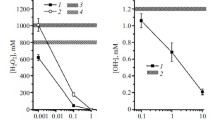The reactions of hydroxyl and glutathiyl radicals with dehydrogingerdione (1) have been studied using biochemical assays and the pulse radiolysis technique in order to understand its radioprotective and antioxidant action. It was found to inhibit the Fenton-mediated 2-deoxyribose oxidation, as well as γ-ray-induced plasmid DNA strand breaks in a concentration-dependent fashion. The pulse radiolysis studies revealed its high reactivity with the hydroxyl and glutathiyl radicals. With the hydroxyl radicals, it initially formed three species, an adduct, a phenoxyl and a methylenic radical. The bimolecular rate constants for the formation of these species were the same (approx. 6.8 × 109 dm3/mol per s). The initially formed adduct also produced the phenoxyl radical at a later stage. In the case of glutathiyl-radical-induced oxidation, an adduct at the α–β double bond was formed as the sole species. Its identity as a carbon-centered radical was inferred from the result of the oxygen effect on the decay of the adduct radical. At a later stage, the adduct radical also produced the phenoxyl radical through an intramolecular radical transformation. A suitable mechanism for the oxidation reactions of 1 has been proposed.
Similar content being viewed by others
Rights and permissions
About this article
Cite this article
Patro, B.S., Adhikari, S., Chintalwar, G.J. et al. The radioprotection and antioxidant properties of dehydrogingerdione. Res Chem Intermediat 31, 667–678 (2005). https://doi.org/10.1163/1568567054909032
Published:
Issue Date:
DOI: https://doi.org/10.1163/1568567054909032




